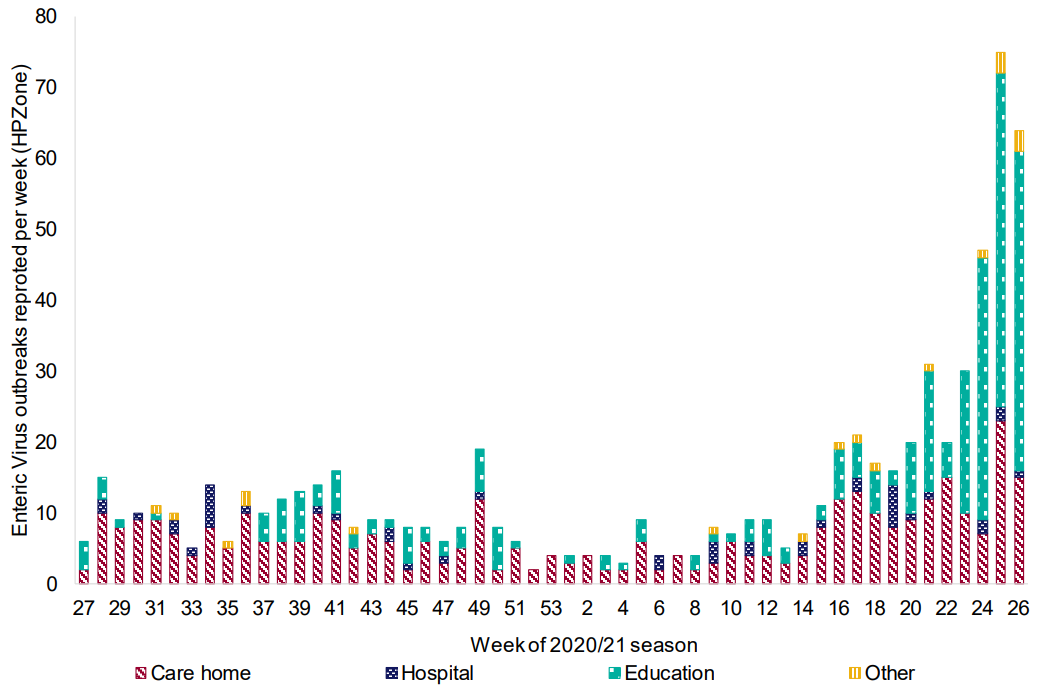Norovirus outbreaks could be avoided with IgY technology

By Technical Team, EW Nutrition
In July, Public Health England (PHE), an executive agency of the Department of Health and Social Care in the United Kingdom, reported a rise of norovirus outbreaks in the country. Norovirus, a highly contagious virus similar to the coronavirus, is the main cause of viral food poisoning from shellfish. Symptoms include vomiting, diarrhea, cramps, as well as muscle aches and headaches.

The PHE press release shows an increase in outbreaks during the last two months, returning to pre-pandemic levels. According to the organization, the number of outbreaks has nearly tripled when compared to the same time period in the last 5 years, affecting people of all age groups and settings in England. Closed places where the virus can spread quickly, especially childcare facilities and nursing homes, are the most affected, as shown below.

Enteric virus outbreaks reported in England during the 2020/2021 season. Source: National Norovirus and Rotavirus Bulletin, Public Health England, 2021 National Norovirus and Rotavirus Bulletin (publishing.service.gov.uk)
Norovirus: A global problem
The issue is not restricted to England. According to the CDC (Centers for Disease Control and Prevention), about one out of every five cases of acute gastroenteritis that leads to diarrhea and vomiting is caused by norovirus, responsible for over 200,000 deaths and a global economic burden of more than $60 billion. The large costs come from healthcare costs and productivity losses and can be seen in low, middle, and high-income countries as shown below.

Global economic burden of norovirus gastroenteritis. Source: https://doi.org/10.1371/journal.pone.0151219.t003
Prevention is key
Noroviruses is easily transmitted through contact with infected individuals or contaminated surfaces. There are many ways to reduce the spread of the virus (e.g., washing the hand thoroughly with soap and water) but prevention is key.
The outbreaks often occur from contaminated oysters or other shellfish which are consumed raw, making foodborne transmission accountable for a considerable number of cases. The conventional cleaning and purifying methods currently used in the industry cannot reliably reduce the number of norovirus contained in its digestive organ, therefore it is of extreme necessity to look new solutions to improve safety in shellfish production. And this is exactly what EW Nutrition does.
Combatting the norovirus: the IgY solution
With our mission to mitigate the impact of antimicrobial resistance in mind, we developed a new technology to improve food safety in shellfish production. Our solution is based on a high value source of natural egg immunoglobulins (IgY), which will prevent the virus from infecting the oyster’s digestive organ.
This method consists in adding anti-norovirus IgY to the seawater during the depuration process, which is a postharvest treatment where the shellfish are placed in tanks of clean seawater to reduce contaminant levels and allow shellfish to cleanse or purge themselves by continuation of their normal filter-feeding and digestive processes.
Natural, effective, and safe
While depuration is a highly effective and very common commercial practice for removing different pathogens, several studies show that the depuration process alone is not enough to remove completely or lower the norovirus to a safe level. On the other hand, various trial results show that shellfish treated with EW Nutrition technology is completely free from or has very low amount of live norovirus, allowing a safe consumption of raw oysters and minimizing the risk of any other outbreaks.
For more information about our solution, you can reach out to Lucas Queiroz or to your local EW Nutrition contact.
References
Bartsch et al. 2016. Global Economic Burden of Norovirus Gastroenteritis. https://doi.org/10.1371/journal.pone.0151219
Lee, R.; Lovatelli, A.; Ababouch, L. Bivalve depuration: fundamental and practical aspects. FAO Fisheries Technical Paper. No. 511. Rome, FAO. 2008. 139p.
National Norovirus and Rotavirus Bulletin, Public Health England, 2021 National Norovirus and Rotavirus Bulletin (publishing.service.gov.uk)
Norovirus outbreaks increasing in England – GOV.UK (www.gov.uk)